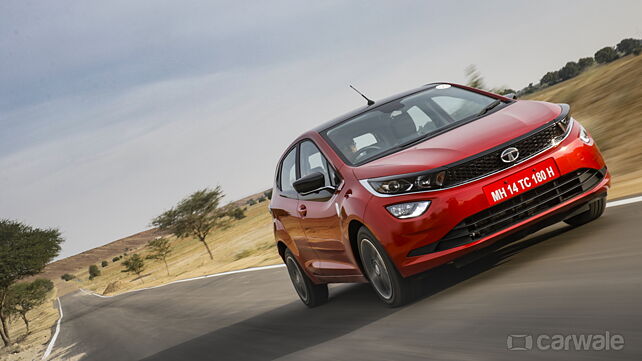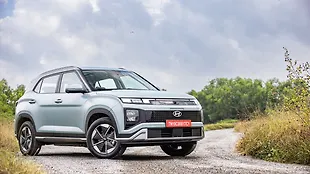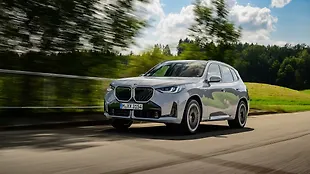What is it?

The Altroz is Tata’s latest, most modern, and its most futuristic looking car. It goes up against the Hyundai i20, the Maruti Suzuki Baleno and its twin, the Toyota Glanza; and not to mention, the Honda Jazz. And when launched next year, expect it to be priced lower than the said competition. And if priced significantly lower, it should be a sweet deal indeed.
And we say that because, to begin with, the Altroz is based on a new, modular platform called ALFA which is lighter than what Tata Motors has been producing so far. The platform is also better built in terms of safety and overall stiffness. Needless to say, it meets all future safety norms in India.

But you can’t see the platform or it’s underpinnings. What you can see is a good looking hatchback. It is beautifully proportioned. It has a unique face which is more cliff-like than one that sweeps back. Plus, the flared wheelarches, the swooping belt-line, and the aggressively cut rear-end lend the Altroz a wonderfully sporty, purposeful, and desirable aura. It has a decently large footprint too. It is wider than most of its competition, if not longer. And the wheelbase of over 2500mm is comparable too. Plus, when you add the not-so-long-hood and the negligible rear overhang to the equation, you get both a large boot that measures over 340 litres, and good interior room.

How is it on the inside?

So, let’s begin with the rear. The first thing that strikes you is how wide these doors open. It’s the same with the front ones, which means if you are short, well, you might struggle to pull them close. But, with a seat that’s anything but low, getting into the Altroz is an easy affair. The seats at the back are comfy too. They are large and supportive, and come with a rear armrest as well. And with the front seat adjusted for my driving position, there was more than enough knee room. The shoulder room is good too and for my height - I measure around five nine - head room is acceptable as well.

At the front, the driving position is agreeable but the seat back design isn’t very comfortable. Plus, with the seat in its lower-most position, thigh support is almost absent. Ergonomically though, the Altroz isn’t half bad. The steering is well-positioned; the gear shifter location feels natural; the floor pedals don’t feel awkward; and all the buttons including those for the power windows, the audio system and the climate control fall easily to hand. The indicator and wiper stalks do feel odd, however.

In terms of equipment, this top-of-the-line XZ trim gets keyless entry and start, electric ORVMs, and cruise control. It also gets a flat-bottom, tilt adjustable steering with controls for audio and voice commands. The driver’s seat is height adjustable. There’s a single zone digital climate control system with rear AC vents. And you get a Harman touchscreen multimedia system complete with Bluetooth telephony, USB connectivity, and Andriod auto and Apple Carplay.

There’s a full-colour driver information system or DIS as part of the instrumentation as well. The DIS looks good and it gives out decent info too. The speedo, however, looks boring and old school, which doesn’t go with the car’s overall design.
Otherwise, the dash design looks good. It is clean. It looks functional. And it is also pleasing to the eye. Nothing seems out of place or forced. And, it has umpteen storage spaces in the central console, the central armrest and the door pockets at the front and rear. What's more, it gets a large glovebox that also cools along with an umbrella holder in the door.

What we would have liked added however, includes metallic outlines for the power window switches, a 60:40 split for the rear seat, turn indicators on the ORVM instead of the front fender, and less exposed rear struts in the boot.
How is it to drive?

The Altroz will be launched with two engine options. A three cylinder, 1.2-litre petrol with a little over 80bhp and a little under 115Nm of peak torque. And on both counts - engine capacity and the engine output - the Altroz doesn’t make any headlines there. These figures are just par for the course.
What we have here though is the diesel. It is a four cylinder unit. It displaces almost 1500cc and puts out 90bhp and 200Nm of peak torque. And this makes it appear better than the Baleno on paper but not as good as the i20. So more middle of the road, if you will.

On the road, unless you rev it to 3,000rpm and beyond, the engine feels refined and quiet. Keep it on the boil though, and it gets noisy. And not just the engine, mind you; on our car we could hear some plastic pieces inside the cabin protesting as well.
It has an alert throttle response all the same. And the power delivery, even with the turbo, is surprisingly linear. And it is a meaty power delivery. The car’s acceleration wouldn’t make you go ‘wow!’ but it keeps you interested and involved.

Ride and handling wise, you can immediately feel that the Altroz runs a stiffer setup. The low speed ride isn’t plush, but it gets better with speed. And the car feels planted and stable no matter the road or the speed. It handles undulations, camber changes, and the odd pot hole we found in Rajasthan quite well.

The steering isn’t great on feel, but it is responsive. And the brakes feel positive and strong too.
Should I buy one?

In terms of specs, the Altroz seems a step behind. It is shorter than the rivals, namely Baleno and Elite i20; it sits on a smaller wheelbase, it has lower ground clearance than the Maruti and Hyundai, and the Hyundai also beats it when it comes to engine specs. What works in the Altroz’s favour though, is its design. You’d want to buy it simply for the way it looks. Then of course it has spacious interiors, a big boot, and decent set of features. But for it to really work, it has to undercut the Baleno and the i20 significantly. And that’s something we will only know in a month's time.
Where does it fit in?

Like we said at the start, when launched in January, the Tata Altroz will compete against the likes of the Hyundai i20, Honda Jazz and the Maruti Suzuki Baleno.
Pictures by - Kapil Angane

































